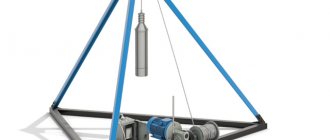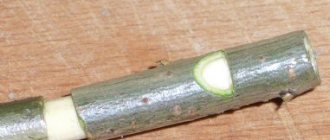The article describes a couple of settings for homemade floats for catching crucian carp.
The technology is taken from the same article, which describes the method of making “Floats for catching bream.”
(By the way, links to most pages with methods for making various baits and tackles are on the “Main Page of the Site”. They are also duplicated in the “Site Map”.)
I only had to slightly alter the settings of the floats for catching crucian carp to suit my tastes.
Therefore, I will present the procedure for their manufacture on my own behalf, without looking at the original article.
And one more circumstance. Fishermen who for the first time want to catch crucian carp or other fish on submerged floats with antennas protruding above the water will have to delve into the principles of setting up such gear, which will be discussed below.
Many of us, when fishing for crucian carp with a float rod, are accustomed to making do with homemade or purchased floats without antennas. At the same time, loading the float devices so that they protrude half or at least a third out of the water.
And this is where their tuning with one sinker or a system of lead pellets ends. In this case, the position of the nozzle on the fishing horizon or at the bottom of the reservoir does not play a special role. Here we will have to deal with fine-tuning the float for catching crucian carp or other fish.
In this case, the foam body of the float has a completely different role. Due to its buoyancy, it must compensate for the relatively considerable weight of the load necessary for long-distance casting of the nozzle, and it itself will be invisible to us. And the float antenna will signal us about crucian bites.
A homemade float made for catching crucian carp (Figure 1) has excellent sensitivity to the most careful fish bites in reservoirs without a current. But for some fishermen, adjusting its load may not seem entirely familiar.
Using a tackle with a second homemade float (Figure 2, shown under the title of the next article), you can catch crucian carp in windy weather, including in a weak, stable current in a reservoir.
Although, in fact, both figures show the design of the same float for catching crucian carp, only they are adjusted differently by the load. The foam body of the float under the number “2” can be made to have a slightly larger load capacity, and the antenna can be made longer.
Therefore, let's agree this way: in the future we will talk about two different indicator devices designed for catching crucian carp under different fishing conditions.
With both homemade floats you can catch not only crucian carp, but also any other fish in similar conditions. But the float shown in Figure 1 is configured for fishing in bodies of water without a current.
And that is not all. Fishing with a fishing rod equipped with a similar float is possible only in areas of lakes and ponds with a relatively flat bottom and, preferably, without wind-raised waves on the water.
These are his negative tuning factors. But they are more than offset by the sensitivity of the float when the crucian carp has to be caught during its sluggish bite.
By the reaction of the antenna of a homemade float for catching crucian carp, you can detect the moment when he just took the bait into his mouth, without even starting to try it.
As for fishing in calm weather, on ponds you can always choose a fishing spot on one side or the other of the reservoir. That is, drive along the dam and position yourself on the shore on the leeward side.
The direction of even the weakest breeze can be determined by the deflection of the flame of a lit lighter. Sometimes before evening fishing for crucian carp, due to the wind changing its direction, you have to move to the other side of the pond.
As for choosing a section of a reservoir with a flat bottom for catching crucian carp, this inconvenience is compensated by casting the nozzle onto the same baited area of the pond bottom.
Good sensitivity of a homemade float for catching crucian carp, shown in Figure “1”, is achieved by minimal resistance from the foam during any action of the crucian carp. The float tracks equally well both the rise of the crucian bait and its movement to the side with the bait in the mouth.
In the first case, we will see an increase in the length of the antenna above the water surface. When the crucian carp moves to the side, it will move the antenna rod in the same direction. At the same time, he began to drown him.
Homemade floats for catching crucian carp have been tested in practice for years. Although setting up any float tackle is a purely individual matter for each fisherman.
The material you will read in this article is just suggestions and recommendations that you do not have to follow.
I also catch crucian carp, tracking its bites not necessarily only with the homemade floats described here.
What is a marker float?
Content
Fishing floats are one of the important elements of equipment. With their help, the user navigates the area and reacts to a bite in time. The marker product allows you to find out all the information about the bottom of the reservoir, identifying each hole and the nature of the soil. It is most advisable to use this device when fishing on a feeder. This way the fisherman can easily find the ideal place and bait the fish. A marker float for feeder fishing is an ideal option for analyzing a reservoir, which takes a minimum amount of time but provides amazing results.
Most often, the product has a cylindrical shape and looks like a dart used in the game of darts. Also in the bundle is a weight (from 40 g to 140 g depending on the current) and a reel. The fishing line, which is located on the reel, is threaded into the eye of this sinker and a float of any type is attached (a wooden block can be used as a material). It is important that the product floats up properly and is above average in size. The final weight of the marker float depends on the weight chosen, but reaches no more than 150 g.
All information about the bottom of the reservoir can be found using a marker float
Making your own marker float
It would be a good idea for a fisherman to learn how to make a marker float himself.
A product for measuring depth can be purchased at a specialized store or you can make a float yourself. This procedure does not require large investments or time.
You can make a marker float with your own hands in several ways. Most often, foam is used as the main material. To do this, a piece of material is made as round as possible so that the resistance from the flow of water is minimal.
Read more
Types of floats and their classification according to fishing conditions
There is also the option of making a marker float from a syringe. To get an effective product, you need to glue a swivel into the tip. This will allow the formation of an eye, which will help tie the float to the tackle. You should attach bright feathers to the back of the syringe, or simply paint over the structure with bright paint.
A homemade marker float can be made from wood or a surprise Kinder box. In the first case, you need to plan a round block, in the second, place a sinker inside. Attaching a fishing line to a plastic egg is very simple: just tie an object (bead, hook, etc.) to the fishing line and place everything in the egg, then close it. Of course, you can make a hole for the fishing line using a hot needle, which will take a little longer, but will be more practical.
You can make a marker float yourself
DIY wing float
Those of us whose passion is float fishing know how difficult it can sometimes be to fish in currents. Especially if it is strong, and you want the hook with the nozzle to be at the bottom. This problem can be solved by purchasing or making a flat float.
The price of branded products, comparable to a wobbler, deters many who want to try this intricate contraption. Others, having purchased a single element of gear that is new to them for testing, and not receiving the expected result, send it to a box with New Year's decorations and lose all interest in such experiments.
But in vain. Perhaps, in these fishing conditions, some parameters of this element simply did not work. Purchasing or manufacturing a series of similar elements with different characteristics (for different fishing conditions) facilitates their mastery during the fishing process. The design of the flat float was developed by E. Gutkevich and is currently produced by a wide range of manufacturers. The float has a disk shape and a narrow elongated cross-section, for which it received the nickname “lollipop” from fans of fishing with a plug.
Such floats “cut” the water, providing little resistance to the flow, and at the same time allow you to make the tackle more sensitive, in comparison with the use of a conventional spindle-shaped float, to perform wiring with a rigid hold or even stop the tackle. Hold the bait in the fish feeding area for as long as possible.
Many people prefer to make floats themselves; in this article I will tell you how to make a flat float. Firstly, there is a problem with the choice of material. We need a light, durable, easy-to-work “in the kitchen” material. It should not take on water if damaged.
Must be chemically resistant to nitro varnishes and paints. And finally, it must be cheap. Such material was found - it is polypropylene foam. On the construction market you can find so-called “plaster trowels”. By purchasing one of these, you will fully provide yourself with the necessary supply of floats. This will cost approximately 150–200 rubles. You will also need a quick-drying nitro varnish - there is no point in stretching out the production for months.
You will also need steel wire for the keels and antenna and “Moment” glue. The tools we will use are a hacksaw, a knife, a thin drill (1–1.2 mm), fine-grained emery cloth, and pliers.
Selecting size and shape
Practice has shown that a finished float with a diameter of 65 mm and a maximum thickness of 6 mm has a load capacity of about 9 g. By increasing the thickness to 8 mm and slightly changing the shape of the body, you can get a load capacity of about 15 g! Now about the form. In the horizontal cross section we should get a symmetrical wing with a wide front part and a narrow tail. And with increasing load capacity, this cross-section becomes wider.
Primary processing of the workpiece
Using a metal hacksaw, we cut a square from the grater with a side 2 mm larger than the diameter of the future float. Use a knife to give it a shape close to the required one. We retreat 2–3 mm from the edge of the float and make notches with a knife along the entire perimeter of the workpiece. The fact is that when making a grater, the surface layers turn out to be very hard and unsuitable for our purposes. Carefully, little by little, cut off the excess material with a knife.
Finishing
Place the workpiece on sandpaper and grind the side surfaces in a circular motion to the required thickness. First one, then the second. Pay attention to the parallelism of the planes - this will subsequently affect the symmetry of the float. We also process the workpiece around the perimeter.
Then, using a simple pencil, draw a midline along the perimeter - this will be a guideline when finishing the body to the shape of a wing. Subsequent processing with sandpaper is the most painstaking process. It will require patience, an eye and accuracy. However, it's not that difficult. After rounding the edges in the front part, we drill holes for the keel and antenna. The angle between them should be 30–40º.
A steel wire with a diameter of 0.8–1.2 mm is suitable as a keel. Preferably stainless steel. We insert a piece of wire 35–40 cm long into the hole and bend it as shown in the photo. The shoulder obtained in this way is necessary for more reliable fixation in the body of the float.
And at the same time we form the upper point of attachment of the float to the fishing line - a loop or pin (as you like). We drill a hole in the telefloat and strengthen the shoulder. Then we glue the keel in those places where it comes into contact with the body. We also glue in the antenna. We put a silicone cambric on the upper cleat of the keel and another one on top - to fix the fishing line between them.
It was experimentally established that after covering the body with varnish in several layers, the load of the float increases by 0.6–0.7 g (this is most likely due to the fact that air bubbles remain in the pores of the material that are not varnished, which increase the load capacity). We take a piece of fishing line, silicone cambrics, and lead pellets of known weight. And measure the resulting load in the flask. At the same time, remember that such floats are placed in the middle of the antenna!
If it is more than required, we process it with sandpaper until the float load is the required plus the specified correction. Moreover, it is necessary to process from the sides so that the shape remains symmetrical. If the float has a significantly greater carrying capacity, it should also be processed around the perimeter of the tail section. Before the next step, the float must be thoroughly dried.
Varnish coating
Foampropylene is a porous material. But, as practice has shown, bringing the surface to a perfectly flat surface does not make sense. This does not affect the performance of the float, but increases the complexity of manufacturing. Therefore, it will be enough for us to cover the float with 6 layers of varnish. To do this, we wind the insulating tape onto the antenna and the keel.
Take a nail polish brush (it must first be cleaned of any remaining old polish) and quickly apply the polish to one of the surfaces of the float, holding it horizontally. Then we turn the float over to the other side and repeat the procedure. Since our varnish is quick-drying, the waiting time between coats does not exceed 10 minutes. In this case, the varnish does not dry completely. But the surface becomes suitable for applying the next layer.
Marker float accessories
Installation of the marker float should begin by threading the fishing line into the eye of the sinker. It should move easily through the material without creating burrs or injuring it. A stopper must be secured at a distance of 20 cm from the end of the fishing line. The material can be a bead or a rubber fragment. This element should not move along the fishing line; accordingly, it should be well secured.
The float should be attached to the very end of the fishing line. The result of the process depends on the quality of fastening.
Attaching a float for crucian carp to a fishing line
Homemade floats for crucian carp are removable. Twists of copper wire are glued into the lower bases of the float devices. Fastening to the fishing line is carried out using a bypass loop.
To do this, the fishing line is folded in half, threaded into a ring and wrapped around the float. After this, the fishing depth is adjusted.
Then the loop is tied into a knot. Removing homemade floats for crucian carp is carried out in the reverse order. In the upper part of the float body, you can glue another bracket for the fishing line.
As already written above, the inconvenience of the float settings proposed above is that we can catch crucian carp only in reservoirs with calm water.
The homemade float for crucian carp, shown in Figure “3,” is configured somewhat differently than that discussed in the previous article. This type of fishing rod is designed for long-distance casting of bait.
After casting the tackle, the float is “anchored” by a sliding weight on the ground. Therefore, it is not the same as the first one reacts to the wave. And a thin antenna 10-12 centimeters long simply cuts it through.
The point of setting up the tackle is to install the manufactured float on the fishing line in such a position that after casting the tackle, it is submerged in the water to the base of the antenna by a sliding bottom weight (D). That is, as shown in Figure 3.
The antenna is glued into the foam using the same method as on floats for catching bream. The link is at the beginning of the page.
How to use a marker float correctly?
Use in standing water
Before making the product, you need to figure out how to measure the depth while fishing with a marker float. You need to start the process by throwing the equipment into the water. Afterwards, the fisherman needs to wait until the sinker reaches the bottom. At the next stage, wind the line until the float stops in the eye of the weight. For convenience, marks are made about the line level at the reel itself, and the line is lowered to allow the float to float up. Bleeding stops when the marker comes out of the water. Next, a second mark is made. At the end of the procedure, you need to unwind the fishing line and measure the distance of the marks.
It’s as easy as shelling pears to measure the depth of a reservoir using a marker float
On reservoirs, using floats to help measure depth is as easy as shelling pears. Standing water gives virtually no error, and due to the absence of current, the product ideally floats above the weight. The advantages are the absence of bending of the fishing line, quick ascent and minimal time spent on analyzing the depth of the reservoir.
A fisherman can purchase a unique marker float with a light sensor, which will improve fishing conditions.
Use on the current
The current is not the most favorable option for measuring depth. This is because the float sinks in one place and floats up in a completely different place (if the water flow is strong). This gives a large error. In addition, the bending line is lost, which also negatively affects the accuracy of measurements.
Read more
How to catch trout with a bombard?
To solve this problem, you can use heavier weights and choose floats that have a flat shape. For fishing in the current, the Marker Float 80 marker float is ideal.
Among the popular and effective models is the ESP marker float, made of high-quality plastic. The product has proven itself to be durable, extremely buoyant and aerodynamic, resulting in high precision casting.
Use in ponds with silty soil
The use of a depth meter in silty soil also has its disadvantages, the main one of which is the ability of the weight to bury itself in the soil to its maximum depth, which will affect the accuracy of the measurement. This problem can be avoided in two ways: using a plastic bottle to build a kind of umbrella for the weight, or using weights of a spherical, pyramidal shape, i.e., products with an increased area.
In any case, problems with the use of this type of float are easy to solve. Anyone can make a product, because the process uses available tools. The fisherman will definitely like this device and will help him catch more fish.
Originally posted 2018-08-10 14:46:40.








